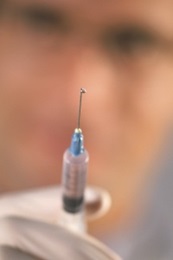Perthes Disease (Legg-Calve-Perthes Disease)
What You Need to Know
- Legg-Calve-Perthes is a rare hip condition affecting children younger than 10 years old.
- The cause of Legg-Calve-Perthes disease is currently unknown.
- Children with Legg-Calve-Perthes disease often develop a noticeable limp and may have some pain in the hip, pelvic and upper leg areas.
- A physical exam, X-rays and an MRI scan are often used to diagnose Legg-Calve-Perthes disease.
- There are medical and surgical treatments for Legg-Calve-Perthes disease, but surgical procedures are often not recommended for children under 6.
What is Legg-Calve-Perthes Disease?
Legg-Calve-Perthes disease, also known as Perthes disease, is a disorder of the hip in young children that usually occurs between the ages of 4 and 10.
The hip is made up of the femoral head — the “ball,” which is the upper part of the femur — and the acetabulum — the “cup” that fits around the femoral head.
In Perthes disease, the blood supply to the head of the femur is interrupted. The femoral head then “necroses,” or loses blood supply, which weakens the bone and can lead to multiple fractures. Next, the bone is taken up by the body, or resorbed, which can lead to a complete collapse of the femoral head.
The blood supply does eventually return and the bone will re-form, or re-ossify. However, the bone may re-form with a different shape than it had before. Because of this, degenerative joint disease (osteoarthritis) can develop later in life.
What causes Legg-Calve-Perthes disease?
There are several theories. As mentioned above, the supply of blood to the femoral head is lost. The reasons for this, however, are unclear. It might be due to trauma that damages the blood vessels or to disorders that cause the blood to clot and clog up the veins.
What are the risk factors of Legg-Calve-Perthes disease?
Legg-Calve-Perthes disease affects less than 1 percent of the general population and is therefore very rare, but it is four times more common in boys than girls.
Studies have also shown that children with parents who have the disease are more likely to get it. In fact, between 2 and 10 percent of children with Perthes disease have at least one family member with the disease.
What are the symptoms of Legg-Calve-Perthes disease?
Children with Legg-Calve-Perthes disease often develop a noticeable limp. They may also experience stiffness of the hip or complain of mild pain in the groin area, thigh or knee. This pain is usually worse with activity and improves with rest.
Legg-Calve-Perthes Disease Diagnosis
A pediatric orthopaedic specialist will look to see if the child has problems rotating the leg. The thigh, calf and buttock muscles can “atrophy,” or become smaller, if the affected limb goes a long time without use. The specialist may also notice that the affected leg is shorter than the normal leg in cases where Perthes disease has been going on for a long time.
If Legg-Calve-Perthes disease is suspected, the provider will obtain X-rays of your child’s hips. Often, a specialty MRI scan will also be recommended to determine how much of the blood supply in the hip is affected.
Legg-Calve-Perthes Disease Treatment
Nonoperative Treatment
It is very important to keep the joint moving. This is because the cartilage on the femoral head depends on the liquid in the joint, called the synovial fluid, for its nutrition. Moving the hip helps to supply the cartilage with this fluid.
It is also important to keep the head in the hip socket so that when the bone does re-form, it has the best and most round shape possible. Sometimes, the child’s hip becomes stiff and may need help to keep the ball in the cup. Your doctor may recommend a period of casting, bracing and/or physical therapy to help achieve this.
Surgical Treatment
Surgery may be warranted to treat Legg-Calve-Perthes disease, but is often not recommended for children under the age of 6. The goal of surgery is containment. The idea is to keep the femoral head within the acetabulum. To do this, the pediatric orthopaedic surgeon may alter the angle of the bones of the femur and/or acetabulum and fix them in a more anatomically correct position. This procedure, called an osteotomy, allows the femoral head to grow in its normal spherical fashion.
Are there complications of Legg-Calve-Perthes disease?
Yes. The head of the femur may lose its normal spherical shape and/or collapse. Also, degenerative joint disease can occur (i.e., as occurs in osteoarthritis). The affected leg may lose some of its motion and may become shorter than the normal leg.
How will my child with Legg-Calve-Perthes disease do in the long run?
This varies from patient to patient. The presence of some signs usually carries a worse prognosis. These include the development of Legg-Calve-Perthes disease when the child is older than 8, the development of poor range of motion and the presence of a nonround femoral head even after treatment.
In most patients, pain resolves during the teenage years. However, it is estimated that approximately 50 percent of patients who develop Legg-Calve-Perthes disease as a child will need a hip replacement by later adulthood (i.e., 50 to 60 years old).





